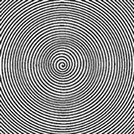New Projects Set in Motion by SIAG/Dynamical Systems
May 9, 2001

As the poster created to introduce SIAM's new all-electronic journal on dynamical systems makes clear, illustrations in the field are best appreciated in an electronic setting. Shown here, from the poster, is an image produced by Jay Fineberg, Daniel Lathrop (a member of the SIADS editorial board), and Ben Zeff in their experimental work on surface waves.
With Marty Golubitsky and SIAM vice president for publications Mac Hyman, Guckenheimer visited the SIAM offices in February to work out the details of two new coordinated SIAM projects---known as SIADS and DSWeb---created to bring the diverse dynamical systems community together.
SIADS, the SIAM Journal on Applied Dynamical Systems, is a new SIAM journal---SIAM's first all-electronic journal and for that matter its first new journal of any kind in more than a decade. The electronic format, says Golubitsky, who is the new journal's editor-in-chief and also the current chair of SIAG/DS, will allow some features that are especially appealing, and in some ways essential, to dynamical systems researchers---among them free, unlimited use of color and animation. "It is not just a print journal done electronically," Golubitsky emphasizes.
As to the other new acronym, DSWeb is a Web portal for the dynamical systems community. Guckenheimer, the first managing editor of DSWeb, sees it as "the entry site to everything you want to know about dynamical systems." DSWeb has been created in part to post supplementary material submitted by SIADS authors with their journal papers.
SIADS and DSWeb will be introduced formally later this month, with a call for papers, at the Sixth SIAM Conference on Dynamical Systems, Snowbird, Utah, May 20-24. Another distinguishing feature of the conference will be the first presentation of the two prizes of the SIAM Activity Group on Dynamical Systems: the J�gen Moser Lecture and the John David Crawford Prize.
New Resources for Authors
SIADS is unique in the capabilities it offers to authors, Golubitsky says, adding that the journal may well function as a prototype for SIAM. With both SIADS and DSWeb, SIAM is systematically exploring ways to take advantage of electronic means of communication, and the new resources may also prove to be appropriate for other research areas of interest to the SIAM membership.

SIADS offers researchers "a new way to communicate and visualize dynamics." Also from the poster is this image of a numerical simulation of spiral waves from Bj�rn Sandstede and Arnd Scheel. Sandstede, a member of the SIADS editorial board, is the first recipient of the J.D. Crawford Prize.
The electronic bells and whistles aside, Golubitsky makes it clear that SIADS is to be a high-end journal. "It is the content that will drive it," he says, "and we are excited to be starting the journal with a first-class editorial board in place."
The new journal, as stated in its editorial policy,
publishes research articles on the mathematical analysis and modeling of dynamical systems and its application to the physical, engineering, and life sciences. . . .The use of color, animated visualizations, and internal linking is strongly encouraged where it enhances the exposition, but papers without these enhancements are accepted as well; review is based on research content.
Submitted articles should contribute to either the theory of dynamical systems, the understanding of dynamical systems phenomena through experiment or numerical simulation, or the use of dynamical systems methods in applications. Contributions . . . may be of a theoretical, computational, or experimental nature.
Articles for the SIAM Journal on Applied Dynamical Systems must contain substantially new results and relate them to existing literature in a scholarly fashion.
DSWeb
"Journals are archival, but not all scholarly work is archival," Guckenheimer points out. The Web portal will give people a more substantial outlet for their work, he says, in particular work that may not be archival.
DSWeb has sections, each of which has a section editor and a small editorial board. Sections envisioned to date include a dictionary/glossary, picture gallery, moderated news group, software exchange, and tutorials; among other ideas being considered are a magazine (containing news and opinion pieces, along with informal articles of general interest), a section devoted to information about the field and about SIAG/DS, and a section on applications of dynamical systems theory.
Like SIAG/DS in general, DSWeb has as a major goal the posting of material that will be useful to people just getting into the field.

